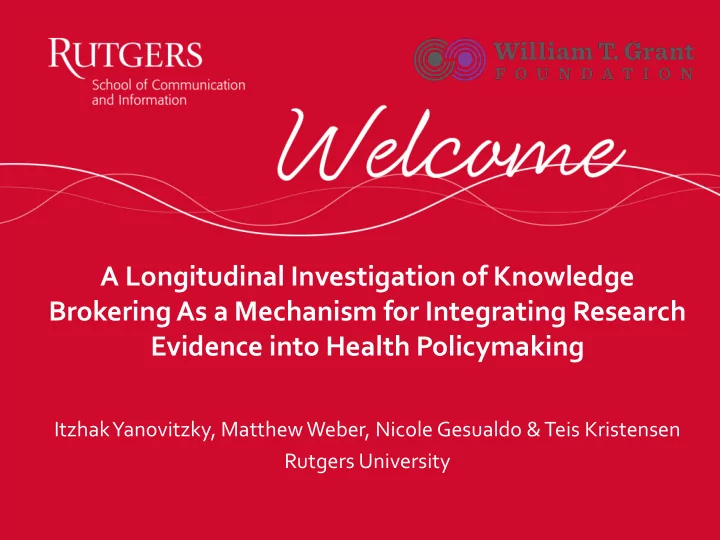

A Longitudinal Investigation of Knowledge Brokering As a Mechanism for Integrating Research Evidence into Health Policymaking Itzhak Yanovitzky, Matthew Weber, Nicole Gesualdo & Teis Kristensen Rutgers University
Knowledge Brokers A knowledge broker is an intermediary (an organization or a person), that aims to develop relationships and networks with, among, and between producers and users of knowledge.
Knowledge Brokering In the public policy domain, knowledge brokering is a dynamic activity that regulates the flow and exchange of policy- relevant information (i.e., about the problem, alternative solutions, and political climate) to and from policy actors who are not directly connected. Through their information behavior (e.g., sharing, withholding, filtering , and interpreting information), influence (reputation, authority), and carrying capacity, knowledge brokers dynamically Information Flow regulate the scope, nature, and speed in which policy-relevant information travels within the policy system.
Study Methodology Qualitative and quantitative content analysis of all Congressional documents concerning public policies to decrease childhood obesity from 2000-2014 ( N ≈ 1,578 documents). All excerpts containing explicit reference to evidence were coded for source, type, and context of evidence use, interpretation of evidence, and the purpose for which it was used (conceptual, instrumental, political, tactical, and symbolic). Network analysis (two-mode and one-mode) of suppliers and users of research evidence was created based on the actors referenced in each document and was used for tracking the flow of research evidence among actors over time.
Study Methodology
Use of Evidence Patterns Evidence in Bills Evidence in Hearings (n = 1360) (n = 2103) Type of Evidence Statistical facts 87% 57% Research study findings 10% 16% Expert opinion - 10% Source of Evidence None referenced 63% 50% CDC/NIH 22% 10% Anecdotal evidence - 7.5% Academic research 1.4% 3.5%
Use of Evidence Patterns Evidence in Bills Evidence in Hearings (n = 1360) (n = 2103) Use of Evidence Conceptual 94% 71% Instrumental 3.5% 12% Political 2% 13% Interpretation Objective status of problem 74% 48% Cause of problem 17% 16% Possible solution to problem 8% 17% Preferred policy response 0.5% 6.5%
Policy Windows Childhood Obesity-Related Legislative Actions, 106-113 Congress 70 Presiden t: Obama 60 House : Democrat Senate : Democrat Presiden t: Bush 50 House : Republican Senate : Republican 40 Bills 30 Hearings 20 10 0 106 107 108 109 110 111 112 113
Bill Sponsor Network Overview
2008 Bill Sponsor Network
2010 Bill Sponsor Network
2012 Bill Sponsor Network
Key Metrics by Period Top five actors in each year, based on Burt’s measure of network efficiency; this measure indicates the actors that are positioned structurally to most effectively broker knowledge exchange with others. 2008 2010 2012 Kind (4.81) Grijalva (41.1) Johnson (14.2) Baldwin (1) Fudge (35.5) Kucinich (14.2) Bishop (1) Payne (32.2) Baca (1.9) Bordallo (1) Polis (27.3) Carnahan (1.9) Brown (1) Andrews (26.5) Clarke (1.9)
Example of Analysis by Party Affiliation
Evidence Acquisition Sources of Evidence Used in Congressional Hearings, 107-113 Congress 60 50 40 30 20 10 0 107 108 109 110 111 112 113 Generic CDC/NIH/IOM Foundations/Think Tanks Experts Academic
Evidence Interpretation Interpretation of Evidence Use in Congressional Hearings, 107-113 Congress 80 70 60 50 40 30 20 10 0 107 108 109 110 111 112 113 Objective Status Causes Solutions
Evidence Use Purpose of Evidence Use in Congressional Hearings, 107-113 Congress 100 90 80 70 60 50 40 30 20 10 0 107 108 109 110 111 112 113 Conceptual Instrumental Political
Conclusion Opportunities for knowledge brokering in the macro-level policy context are not fixed or limited to particular actors; rather they emerge dynamically in the course of the policymaking process as a function of the interplay between individual actors’ agency (e.g., policy champions) and characteristics of the political environment in which they operate. Knowledge brokers can be most effective when they have the capacity, motivation, and political opportunities to broker use of evidence. It is important to recognize that the scope, nature, and use of the evidence engaged by policymakers is different at different stages of the policymaking process and that a better understanding of the factors that influence differential use is crucial for informing decisions about the content, format, and timing of research evidence dissemination efforts.
Recommend
More recommend